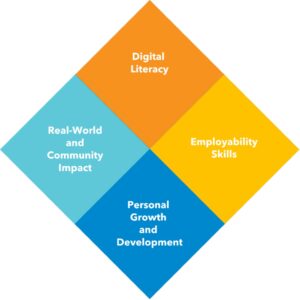Co-curricular framework
CCR is enhanced with our newly developed Co-Curricular Framework.
Four pillars. Sixteen competencies. Countless learning moments.
Learning is not meant to be linear. Let’s explore and find the missing piece of the puzzle together and further complete your co-curricular learning experience.
Why design a Co-Curricular Framework?
The framework was designed with Columbia College’s mission of equipping students to become responsible global citizens in mind. It aligns with our vision to provide opportunities for students to contribute to positive social change. It also has strong ties with our values of embracing opportunities for improvement.
We want to provide you with as many opportunities as possible to strengthen your skills under these four pillars: Digital Literacy, Employability Skills, Personal Growth and Development, and Real-World and Community Impact.

What are the Co-Curricular Competencies?
A co-curricular pillar encompasses an array of topics and skills, which are broken down into more detailed co-curricular competencies. These competencies are technical or soft skills you are expected to acquire upon completing a co-curricular opportunity. Consider this:
Click on the competencies below for more information on how they further your skills:

